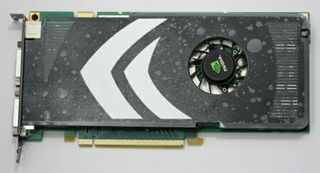New Nvidia GeForce 8800GT Surprises
GeForce 8800GT: The Card and New Antialiasing Capability


There's been a big visual change, the GeForce 8800GT has a single-slot design again, with all the advantages and inconveniences that carries; it takes up less space on the motherboard and in the case, and it's lighter, but the heat spreaders and fan aren't as thick (and thus less effective at a given level of noise) and hotter air is thrown around the case.
The cooling system spreads over the whole surface of the card (à la 8800 Ultra) and only features a radial fan with a diameter of approximately 6 cm (2"). The card is indeed quite light - 411g (14.5 oz) comparing to the 732g (25 oz) of the 8800GTX - due to heat spreader made of aluminum; only the traditional flat heat pipes are made of copper.
Despite its GPU using a 65 nm process, the GeForce 8800GT still requires an additional PCI Express 6-pin power cable. Nvidia talks, as a matter of fact, about a maximal consumption of 105 W. Finally, some very good news (here again pointed at the high end market, so not really for this card), the two DVI ports support simultaneous HDCP and dual-link (meaning a possible 2560 x 1600 for 30"). This is the first card to boast this feature, others being incapable of the feat. Given the fact HDMI is supported natively, manufacturers may choose to integrate a port, or otherwise, you may have to use an (expensive) DVI to HDMI adapter.
Finally, it should be noted that this card introduces a new transparent antialiasing algorithm, this is meant to be a better compromise between the previous multisampling (TRMS, very fast, but with not much improvement) and the supersampling (TRSS, more costly, but it really enhances scenes with gates, for instance).
Stay on the Cutting Edge
Join the experts who read Tom's Hardware for the inside track on enthusiast PC tech news — and have for over 25 years. We'll send breaking news and in-depth reviews of CPUs, GPUs, AI, maker hardware and more straight to your inbox.
Current page: GeForce 8800GT: The Card and New Antialiasing Capability
Prev Page GeForce 8800GT: The Chip Next Page GeForce 8800GT: The Card and New Antialiasing Capability, ContinuedMost Popular

